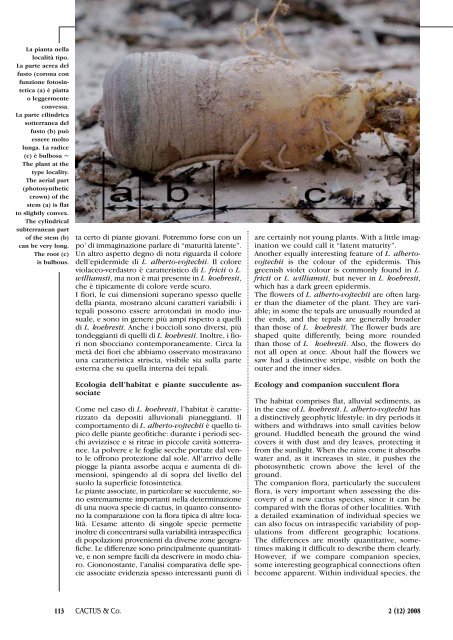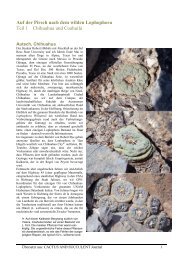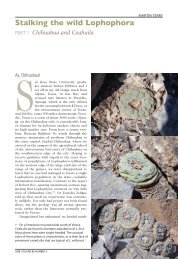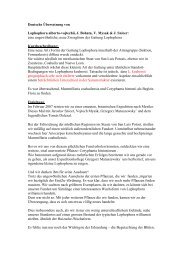alberto-vojtechii - Lophophora.info
alberto-vojtechii - Lophophora.info
alberto-vojtechii - Lophophora.info
You also want an ePaper? Increase the reach of your titles
YUMPU automatically turns print PDFs into web optimized ePapers that Google loves.
La pianta nella<br />
località tipo.<br />
La parte aerea del<br />
fusto (corona con<br />
funzione fotosintetica<br />
(a) è piatta<br />
o leggermente<br />
convessa.<br />
La parte cilindrica<br />
sotterranea del<br />
fusto (b) può<br />
essere molto<br />
lunga. La radice<br />
(c) è bulbosa ~<br />
The plant at the<br />
type locality.<br />
The aerial part<br />
(photosynthetic<br />
crown) of the<br />
stem (a) is flat<br />
to slightly convex.<br />
The cylindrical<br />
subterranean part<br />
of the stem (b)<br />
can be very long.<br />
The root (c)<br />
is bulbous.<br />
113<br />
ta certo di piante giovani. Potremmo forse con un<br />
po’ di immaginazione parlare di “maturità latente”.<br />
Un altro aspetto degno di nota riguarda il colore<br />
dell’epidermide di L. <strong>alberto</strong>-<strong>vojtechii</strong>. Il colore<br />
violaceo-verdastro è caratteristico di L. fricii o L.<br />
williamsii, ma non è mai presente in L. koehresii,<br />
che è tipicamente di colore verde scuro.<br />
I fiori, le cui dimensioni superano spesso quelle<br />
della pianta, mostrano alcuni caratteri variabili: i<br />
tepali possono essere arrotondati in modo inusuale,<br />
e sono in genere più ampi rispetto a quelli<br />
di L. koehresii. Anche i boccioli sono diversi, più<br />
tondeggianti di quelli di L. koehresii. Inoltre, i fiori<br />
non sbocciano contemporaneamente. Circa la<br />
metà dei fiori che abbiamo osservato mostravano<br />
una caratteristica striscia, visibile sia sulla parte<br />
esterna che su quella interna dei tepali.<br />
Ecologia dell’habitat e piante succulente associate<br />
Come nel caso di L. koehresii, l’habitat è caratterizzato<br />
da depositi alluvionali pianeggianti. Il<br />
comportamento di L. <strong>alberto</strong>-<strong>vojtechii</strong> è quello tipico<br />
delle piante geofitiche: durante i periodi secchi<br />
avvizzisce e si ritrae in piccole cavità sotterranee.<br />
La polvere e le foglie secche portate dal vento<br />
le offrono protezione dal sole. All’arrivo delle<br />
piogge la pianta assorbe acqua e aumenta di dimensioni,<br />
spingendo al di sopra del livello del<br />
suolo la superficie fotosintetica.<br />
Le piante associate, in particolare se succulente, sono<br />
estremamente importanti nella determinazione<br />
di una nuova specie di cactus, in quanto consentono<br />
la comparazione con la flora tipica di altre località.<br />
L’esame attento di singole specie permette<br />
inoltre di concentrarsi sulla variabilità intraspecifica<br />
di popolazioni provenienti da diverse zone geografiche.<br />
Le differenze sono principalmente quantitative,<br />
e non sempre facili da descrivere in modo chiaro.<br />
Ciononostante, l’analisi comparativa delle specie<br />
associate evidenzia spesso interessanti punti di<br />
are certainly not young plants. With a little imagination<br />
we could call it “latent maturity”.<br />
Another equally interesting feature of L. <strong>alberto</strong><strong>vojtechii</strong><br />
is the colour of the epidermis. This<br />
greenish violet colour is commonly found in L.<br />
fricii or L. williamsii, but never in L. koehresii,<br />
which has a dark green epidermis.<br />
The flowers of L. <strong>alberto</strong>-<strong>vojtechii</strong> are often larger<br />
than the diameter of the plant. They are variable;<br />
in some the tepals are unusually rounded at<br />
the ends, and the tepals are generally broader<br />
than those of L. koehresii. The flower buds are<br />
shaped quite differently, being more rounded<br />
than those of L. koehresii. Also, the flowers do<br />
not all open at once. About half the flowers we<br />
saw had a distinctive stripe, visible on both the<br />
outer and the inner sides.<br />
Ecology and companion succulent flora<br />
The habitat comprises flat, alluvial sediments, as<br />
in the case of L. koehresii. L. <strong>alberto</strong>-<strong>vojtechii</strong> has<br />
a distinctively geophytic lifestyle: in dry periods it<br />
withers and withdraws into small cavities below<br />
ground. Huddled beneath the ground the wind<br />
covers it with dust and dry leaves, protecting it<br />
from the sunlight. When the rains come it absorbs<br />
water and, as it increases in size, it pushes the<br />
photosynthetic crown above the level of the<br />
ground.<br />
The companion flora, particularly the succulent<br />
flora, is very important when assessing the discovery<br />
of a new cactus species, since it can be<br />
compared with the floras of other localities. With<br />
a detailed examination of individual species we<br />
can also focus on intraspecific variability of populations<br />
from different geographic locations.<br />
The differences are mostly quantitative, sometimes<br />
making it difficult to describe them clearly.<br />
However, if we compare companion species,<br />
some interesting geographical connections often<br />
become apparent. Within individual species, the<br />
CACTUS & Co. 2 (12) 2008







